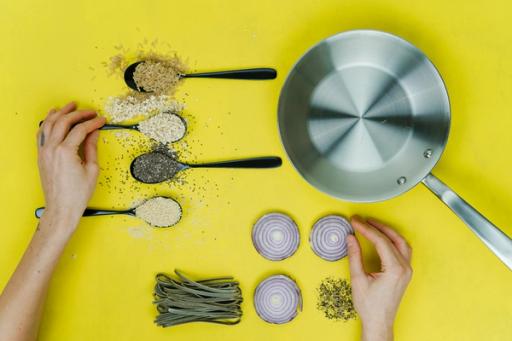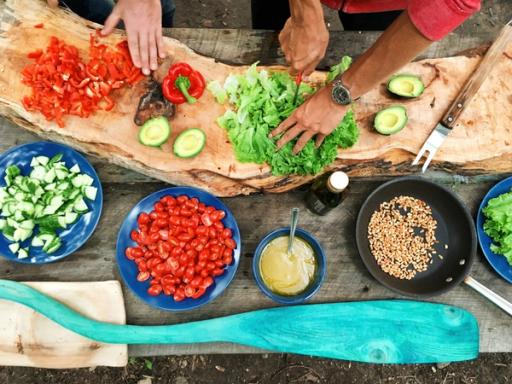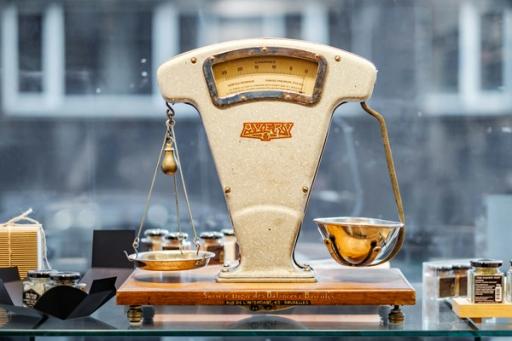
Cooking makes it easy to prepare multiple servings of your favorite meals and snacks. But when it comes to counting calories, this can get tricky. Instead of eating a single portion of food that you can quickly look up to find the nutrition information, you are now faced with several servings of a dish that you need to dissect to find the correct calorie count. Instead of panicking, let’s walk through how to count calories when cooking so you can get back to enjoying your food. This article will help you measure and track calories while cooking, ensuring accurate nutrition and portion control for your health and fitness goals. How Are Calories Measured? Cal AI’s Calorie Tracker can help you reach your calorie-counting goals in the kitchen. With simple, user-friendly features, Calorie Tracker efficiently and accurately tracks the calories in your favorite recipes so you can avoid any surprises when it’s time to eat.

Calories measure the energy food or drink provides. When exercising, you can also measure the number of calories burned. You might also see the term calories called kilocalories, often used interchangeably.
Two different units enter the conversation when you’re talking about calories: calories and kilocalories (kcal). While the two terms are often used interchangeably, they are two different units of measurement. In certain countries, like China and Australia, kilojoules (kJ) are also used. Calories can be “small” or “large.” Significant calories measure the energy needed to raise the temperature of 1 kilogram (kg) of water by 1℃. Using this definition, one large calorie equals 1,000 small calories. “Large calories” almost always refers to kilocalories since “kilo” means 1,000. In other words, one large (kilo-) calorie equals 1,000 small calories. While actual measures of small calories are still used in research, they rarely appear outside of scientific studies.
Since small calorie amounts, like 100,000 calories, might appear alarming on a label, calories, and kilocalories have become synonymous in the nutrition world. This means you’re likely seeing kilo- (large) calories on a nutrition label, even when “calories” is used. Basically, in terms of nutrition, kcal and calories are the same. If you’re in a country using kilojoules, there’s no need to fear. It’s easy to convert from one measurement to another, as 1 kcal equals 4.18 kJ. Simply multiply the amount of kcal by 4.18 to find out how many kilojoules your food or beverage contains.
It’s estimated that the average adult needs around 2,000 calories per day. However, the number of calories you should eat depends on many factors, such as:
Your needs may range from 1,500 to 3,500 calories, depending on your health goals. Working with a dietitian can help you pinpoint where within this range you are.
Interestingly, different macronutrients contain different amounts of calories. For example, proteins and carbohydrates provide four calories per gram, while fats provide nine calories per gram.
“Empty” calories, like those in ultra-processed food, still count as calories. They neglect to provide adequate nutrition even though they provide energy. The calories in nutrient-poor foods often come from sugar or unhealthy fats and provide a quick burst of energy followed by an unpleasant “crash.” When choosing between foods and weighing calories, considering macronutrients’s essential. An 8-oz can of soda may contain the same number of calories as an 8-oz glass of 100% juice, although the juice likely contains more nutrients than the soda.
There are many reasons a person may want to count calories. While weight loss often ranks high on the list of potential reasons, being aware of calories can benefit your health in many ways unrelated to weight.
Understanding the calories in food makes you more aware of how energy powers your body. When viewed this way, counting calories can be empowering, as it allows you to make better energy choices for your body over time.
Calories provide an objective unit for measuring energy intake. This makes it easier to estimate your nutritional needs and communicate effectively with your healthcare team. Remember that manufacturers generally round to the nearest gram when calculating calories based on nutrient content. This means there may be minimal variations between what is contained in the food and what is listed on the nutrient label. Understanding calories and macronutrients can help you make educated decisions when comparing different foods and drinks.
Being aware of your calorie intake can help you to make choices that honor your health goals. For example, research has shown that calorie counts displayed in specific locations on a menu may lead to lower-calorie food choices. Since excess calories can contribute to weight gain, noticing the amount of calories in your food can be an essential first step to making meaningful changes. Combining nutritious, low-calorie foods with exercise (which uses up or burns calories) is the start of a great game plan.
To consume fewer calories, start reducing your intake by 500 calories. This small deficit can lead to significant changes by allowing you to lose about 1 pound per week. While this weight loss may not be considered rapid, it promotes a healthier, more sustainable method. Essentially, it’s a way of creating healthy habits that stick instead of rapidly losing weight just to gain it later on. Getting enough nutrients is still essential when you are trying to lose weight. Feel free to count calories to lose weight, but remember that getting all the necessary nutrients is challenging if you drop below 1,200 calories daily. This is often considered where your body switches from thriving to surviving (or “survival mode”).
Counting calorie intake may not be appropriate for some populations. For example, those with disordered eating patterns or a history of eating disorders may not find counting calories helpful. In this case, closely watching calories could cause more harm than good. Other methods may be more helpful if you simply want to enjoy food without thinking about calories.
If you don’t like math, counting calories can sound scary. Estimating calories is an easy method for making sense of food.
There are two common ways used to find the number of calories in a food or beverage:
Using a scale or measuring spoon can help you adhere to your desired calorie count for nutrient-dense foods like peanut butter, allowing you to prepare proper portion sizes each time. It can also be helpful to compare calories from the same food but in different forms. For example, ¼ cups of peanuts contain about 200 calories, and two tablespoons of peanut butter also contain 200 calories.
If you want to focus more on the food you eat instead of the amount of calories, tracking macronutrients (macros) is a more targeted approach. Instead of counting calories, you’ll ensure your body is nourished by getting enough of the three macronutrients (protein, carbohydrates, and fat). Keep in mind that different types of foods contain different numbers of calories. As mentioned above, proteins and carbohydrates provide four calories per gram, while fats provide nine calories per gram. With this knowledge, resources like MyPlate can help you select smaller serving sizes of healthy fats and more significant portions of quality carbohydrates and proteins.
Tracking macros is popular among athletes and other health-minded individuals. It allows them to tailor the percentage of energy they get from each macronutrient.
The recommended ranges (percent of total calories or energy) for adults are as follows:
For example, someone wanting to build muscle and burn fat may aim for 35% of calories from protein, 20% from fat, and 45% from carbohydrates. Remember, a dietitian can help you tailor these macronutrient ranges to best meet your needs.

Cooking changes food. It can alter:
Perhaps most notably, cooking can also change food's weight and volume. When cooked, meat and seafood lose moisture, while grains like rice and pasta absorb water, increasing their size.
For this reason, calorie counts will differ depending on whether you're looking at raw or cooked portions. This is where it gets tricky. Nutritional labels typically refer to raw weights unless otherwise stated. So, if you're tracking calories, it's generally safest to weigh your food before cooking.
Simple practices can yield accurate and consistent measurements. For instance, logging foods before cooking produces the most definite figures because nutrition facts panels reflect a food’s packaged state.
This is especially true for uncooked items like whole grains, lean proteins, and vegetables since their nutrient count remains unchanged by heat or other preparation methods. Altering temperature, altitude levels, or seasoning can influence an item’s weight, as salt has mainly been known to alter moisture content in seafood and meats, changing both volume & mass.
When it comes to cooking, the consequences can be more than just a loss in flavor: Meat and seafood may experience up to 25% shrinkage, while vegetables’ volume could decrease by as much as 50%.
This means that what starts as 150g of sweet potatoes before roasting might become merely 75g after maintaining the caloric count of 150g!
When tracking your diet and calorie count, it’s essential to remember the extra ingredients that are often overlooked. For example, don’t forget about cooking oils when weighing foods after they have been prepared–those added fats can drastically change macro-nutrient ratios!
Entering raw food before preparation helps ensure all the elements of a meal recipe are factored into your calculations.

The standard serving sizes in the U.S. are pretty significant. Even when you know how many calories there are in a serving, loading up your plate with large servings will unintentionally cause you to overload calories.
Rather than the serving sizes, focus on the portions of food you consume at each meal. Initially, you will need to measure the food in grams or ounces, but eventually, you will learn what the recommended half cup of rice or 4 ounces of fish looks like when served on your plate.
The calorie count on labels is for specific serving sizes, usually in grams or ounces. Rather than guessing how much this could be, weigh the food item and measure the portions accurately.
Otherwise, you'll consume more or less than the given serving sizes. Knowing how many grams are in your portion, you can easily calculate the correct number of calories you eat.
Rather than stay under your calorie allowance with any kind of food, focus on the quality of your calories. Reduce processed foods and eat fresh, natural produce. Most of your calories should come from high-quality protein and fat sources, along with some starchy carbs.
Make sure to add plenty of vegetables and some fruits, especially low-calorie ones like berries. Most vegetables are pretty low in calories and offer you loads of:
Many of your ingredients, such as sauces, dips, and salad dressings, have calories and nutritional details on their labels. Don’t be fooled by the low-calorie or calorie-free labels. Low calorie means there are less than 40 calories in a serving size, while calorie-free has less than five calories.
Light/Lite versions contain one-third to half the calories compared to the regular version and may contain other undesirable additives to enhance the taste. Always check the label to see where your calories are coming from.
Rather than complicated calorie counting, simply jot down what you eat all day. When you journal everything you eat correctly, you can take a detailed look at what you have been eating.
You will then be able to weed out the unwanted:
Even if your food choices are healthy, you may be overshooting your daily calorie limit due to too many:
Streamlining your calorie-counting process is vital to ensuring an accurate daily account. Relying on memory to recall what you ate in the morning or even the day before leaves room for errors.
Your calorie-counting system will fail when your food journal is incomplete or contains the wrong serving sizes or portions. Ensure your tracking system is handy before the meal, or record it immediately afterward.
Find a calorie-tracking system that works for you and is easy to maintain. Some people prefer to keep a food journal, while others prefer to take notes on their smartphones or laptops.
Use a simple notepad that you can carry in a pocket or your purse or a calorie-counting app. Numerous apps are available for you to choose from, such as:
Considering that you are counting calories for weight loss, you should also track when you eat your meals. Reserve your higher-calorie meals earlier and reduce your portion sizes later. Have a light dinner in the early evening. Large meals at night hinder your sleep quality and make it much harder to lose those unwanted pounds.
Don’t obsess over every little detail in your meal. While a teaspoon of butter will add extra calories, a few drops of ketchup on your burger will not significantly increase your total calorie intake.
You also do not need to track your calories every day. Even if you do it for a few days, you will still learn a lot about the quantity and quality of your dietary intake.
The easiest way to calculate the calories of meals cooked at home is to choose recipes that are already calorie-tracked. Many recipe books or recipes online already mention the calories from different ingredients or the total calories per serving, which means all the hard work is already done for you.
Simply follow the recipe correctly and track what you add, especially fats such as butter or cheese. Then, calculate and add these to the total calories of the recipe.
Calorie-tracking apps help track your daily food intake, but they can also come in handy when preparing food. The best part is that they allow you count calories in recipes so you don’t have to do it manually, making the process easier and less stressful.
To take it a step further, look for a calorie-tracking app that utilizes artificial intelligence to help you count calories more accurately.
Cal AI transforms calorie tracking with cutting-edge AI technology. Just snap a photo of your meal, and we'll do the rest.
Our app combines your phone's depth sensor with advanced AI models to:
With 90% accuracy on visible foods and multiple tracking options like:
We've made nutrition tracking effortless. Whether you're scanning a full meal or a quick snack, Cal AI
Our AI learns from your feedback to improve accuracy. It includes personalized insights and smart reminders to keep you on track. Cal AI makes achieving your fitness goals simpler than ever. Track your calories with your camera using Cal AI's calorie tracker today!